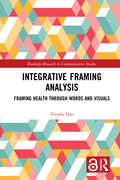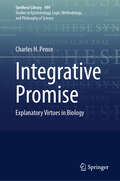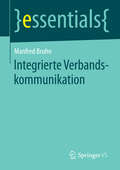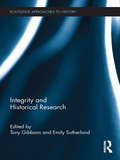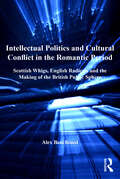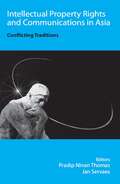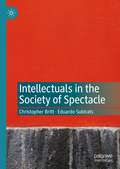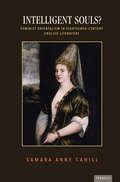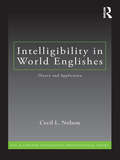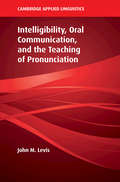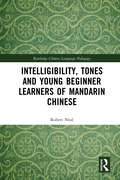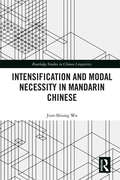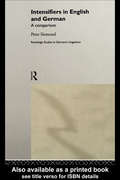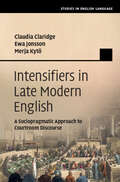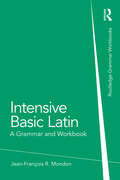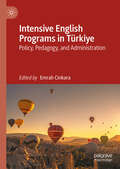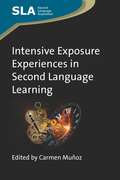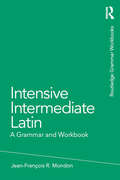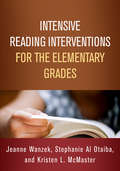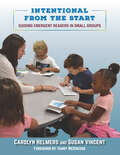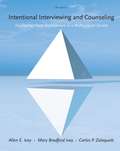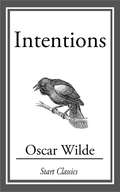- Table View
- List View
Integrative Framing Analysis: Framing Health through Words and Visuals (Routledge Research in Communication Studies)
by Viorela DanMuch of framing scholarship focuses either exclusively on the analysis of words or of visuals. This book aims to address this gap by proposing a six-step approach to the analysis of verbal frames, visual frames and the interplay between them—an integrative framing analysis. This approach is then demonstrated through a study investigating the way words and visuals are used to frame people living with HIV/AIDS in various communication contexts: the news, public service announcements and special interest publications. This application of integrative framing analysis reveals differences between verbal frames and visual frames in the same messages, underscoring the importance of looking at these frames together.
Integrative Promise: Explanatory Virtues in Biology (Synthese Library #499)
by Charles H. PenceThis book offers a new approach to the way in which biologists evaluate both the explanations they give of biological phenomena and those they would like to pursue. Departing from current scholarship on explanation, it draws out a cluster of virtues which unifies some biological explanations and, in turn, captures part of what makes the life sciences distinctive: integrative promise. With case studies drawn from a wide variety of historical and empirical domains (such as big data biology, model organisms, and natural history), as well as theoretical connections to a number of other areas in the philosophy of science (including mechanism, science and values, and scientific modeling), this work creates a new lens which helps us understand why contemporary life science takes the structure that it does. It provides insight for readers in philosophy and history of science, as well as biologists interested in the theoretical structure and future of their field.
Integrierte Verbandskommunikation (essentials)
by Manfred BruhnVerbände haben sich mit einer Vielzahl unterschiedlicher Anspruchsgruppen auseinanderzusetzen. Zudem existieren verschiedene Möglichkeiten der Kommunikation bzw. der Zielgruppenansprache. Die Relevanz einer Integrierten Kommunikation über alle Kommunikationsinstrumente ist daher unbestritten. Der Beitrag zeigt auf, wie die Besonderheiten der Verbandskommunikation im Rahmen einer Integrierten Kommunikation Berücksichtigung finden. Zudem werden Erfolgsbeispiele von Verbänden aufgezeigt, die eine effektive und effiziente Integrierte Kommunikation erfolgreich in der Praxis umsetzen.
Integrity and Historical Research (Routledge Approaches to History)
by Tony Gibbons Emily SutherlandThere have been serious debates between historians, novelists and filmmakers as to how best present historical narratives. When writers and filmmakers talk of using historical research with integrity, what exactly do they mean? Integrity and Historical Research examines this question in detail. The first chapter discusses the concept of integrity. The chapters that follow reflect on this philosophical treatment in the light of fiction and film that deals with history in a number of ways. How should writers and filmmakers use lives? Can, and may, people who are now dead and who may have lived long ago, be defamed? The authors include academics, historians, social historians, medievalists, oral historians, literary theorists, historical novelists and script writers. They examine the theoretical influences and practical choices that involve and concern writers and filmmakers who rely on historical research. The desire to be accurate may often conflict with the need to produce a work that goes beyond the mere depiction of events in order to excite the interest of readers and to hold that interest. At the same time there is a developing emphasis on historians, to write well in clear, accessible prose, which may involve using the novelists’ techniques. How much license may be given to writers of fiction and filmmakers in their depiction of historical characters and events? This book begins to answer this question, while inviting further discussion.
Intellectual Politics and Cultural Conflict in the Romantic Period: Scottish Whigs, English Radicals and the Making of the British Public Sphere (The Nineteenth Century Series)
by Alex BenchimolIntellectual Politics and Cultural Conflict in the Romantic Period maps the intellectual formation of English plebeian radicalism and Scottish philosophic Whiggism over the long eighteenth century and examines their associated strategies of critical engagement with the cultural, social and political crises of the early nineteenth century. It is a story of the making of a wider British public sphere out of the agendas and discourses of the radical and liberal publics that both shaped and responded to them. When juxtaposed, these competing intellectual formations illustrate two important expressions of cultural politics in the Romantic period, as well as the peculiar overlapping of national cultural histories that contributed to the ideological conflict over the public meaning of Britain's industrial modernity. Alex Benchimol's study provides an original contribution to recent scholarship in Romantic period studies centred around the public sphere, recovering the contemporary debates and national cultural histories that together made up a significant part of the ideological landscape of the British public sphere in the early nineteenth century.
Intellectual Property Rights and Communications in Asia: Conflicting Traditions
by Pradip Ninan Thomas and Jan ServaesThis volume explores the contested nature of the ownership of knowledge and access to it in Asia. It offers insights into solving some of the key issues related to intellectual property (IP) and communication in the contemporary world. With the ownership of IP becoming a core feature of media/information industries and state policy, issues related to access to knowledge and its use have become a matter of critical concern. While trade regimes, the state and the core cultural and information industries have begun to advocate greater scope for a variety of knowledge enclosures, civil society is increasingly arguing for a people-centered vision of knowledge futures. This vision includes the need for equity-based and flexible licensing regimes; the legitimacy of local solutions to IP related issues; support for cultural diversity; and access to knowledge based on need rather than the ability to pay for knowledge. This book explores these important issues, supported by case studies from the Asian region. It presents an extensive picture of a dynamic and complex process that reveals some of the dilemmas of the digital age.
Intellectuals in the Society of Spectacle
by Christopher Britt Eduardo SubiratsThis book reveals the sense in which our postmodern societies are characterized by the obscene absence of the intellectual. The modern intellectual--who had once been associated with humanism and enlightenment—has in our day been replaced by media stars, talking heads, and technical experts. At issue is the ongoing crisis of democracy, under the aegis of the société du spectacle and its vast networks of politically-induced idiocy, industrially-produced biocide, and militarily-provoked genocide. Spectacle fills the resulting moral and intellectual vacuum with electronic technologies of control, punishment, and destruction. This postmodern tyranny reduces intelligence to mechanistic, positivist, and grammatological models of inquiry, while increasing the segmentation, fragmentation, and dissolution of human existence. The apotheosis of the spectacle explains the intellectual void that lies at the heart of our postmodern decadence; it also accounts for the need to recuperate the humanist values of enlightenment promoted by the modern intellectual tradition.
Intelligence Communication in the Digital Era: Transforming Security, Defence and Business
by Randolph H. Pherson Rubén ArcosThis edited volume argues that producers of analysis need to shift from producing static, narrative products to much more dynamic, digitally-based platforms in order to remain competitive and relevant.
Intelligent Souls?: Feminist Orientalism in Eighteenth-Century English Literature (Transits: Literature, Thought & Culture 1650-1850)
by Samara Anne CahillIntelligent Souls? offers a new understanding of Islam in eighteenth-century Britain. Samara A. Cahill explores two overlapping strands of thinking about women and Islam, which produce the phenomenon of “feminist orientalism.” One strand describes seventeenth-century ideas about the nature of the soul used to denigrate religio-political opponents. A second strand tracks the transference of these ideas to Islam during the Glorious Revolution and the Trinitarian controversy of the 1690s. The confluence of these discourses compounded if not wholly produced the stereotype that Islam denied women intelligent souls. Surprisingly, women writers of the period accepted the stereotype, but used it for their own purposes. Rowe, Carter, Lennox, More, and Wollstonecraft, Cahill argues, established common ground with men by leveraging the “otherness” identified with Islam to dispute British culture’s assumption that British women were lacking in intelligence, selfhood, or professional abilities. When Wollstonecraft wrote A Vindication of the Rights of Woman she accepted that view as true—and “feminist orientalism” was born, introducing a fallacy about Islam to the West that persists to this day. Published by Bucknell University Press. Distributed worldwide by Rutgers University Press.
Intelligibility in World Englishes: Theory and Application (ESL & Applied Linguistics Professional Series)
by Cecil L. NelsonIntelligibility is the term most generally used to address the complex of criteria that describe, broadly, how useful someone’s English is when talking or writing to someone else. Set within the paradigm of world Englishes – which posits that the Englishes of the world may be seen as flexibly categorized into three Circles (Inner, Outer, Expanding) in terms of their historical developments – this text provides a comprehensive overview of the definitions and scopes of intelligibility, comprehensibility and interpretability, and addresses key topics within this paradigm: Who – if anyone – provides the models and norms for a given population of English users? Hybridity and creativity in world Englishes Evaluating paradigms: misinformation and disinformation Practicalities of dealing with the widening variety of Englishes Is English "falling apart"? The much-debated issue of intelligibility touches not only sociolinguistic theory but all aspects of English language teaching, second language acquisition, language curriculum planning, and regional or national language planning. Designed for students, teacher educators, and scholars internationally, each chapter includes ‘Topics for Discussion and Assignments’ and ‘Suggestions for Further Reading’.
Intelligibility, Oral Communication, and the Teaching of Pronunciation (Cambridge Applied Linguistics)
by John M. LevisA proper understanding of intelligibility is at the heart of effective pronunciation teaching, and with it, successful teaching of speaking and listening. Far from being an optional 'add-it-on-if-we-have-time' language feature, pronunciation is essential because of its tremendous impact on speech intelligibility. Pronunciation dramatically affects the ability of language learners to make themselves understood and to understand the speech of others. But not all elements of pronunciation are equally important. Some affect intelligibility a great deal, while others do not. With a strong emphasis on classroom practice and how pronunciation teaching can be more effectively approached in different teaching contexts, this book provides an important resource for pronunciation researchers, with a distinctly practical focus. It shows how intelligibility research informs pronunciation teaching within communicative classrooms, enabling language teachers to incorporate intelligibility findings into their teaching. Professionals interested in oral communication, pronunciation, and speech perception will find the book fascinating.
Intelligibility, Tones and Young Beginner Learners of Mandarin Chinese (Routledge Chinese Language Pedagogy)
by Robert NealTwo decades ago, Mandarin Chinese seemed set to become a mainstream school subject in Anglophone settings. Yet current learning outcomes are generally disappointing. Is Chinese too difficult for learners at this level? Should it be left to the posh kids with pushy parents?Set within the context of teaching and learning Chinese at an inner-city secondary school in the North of England, and adopting a case study research design, this book aims to develop research-informed insights into the nature of the pronunciation challenges facing beginner learners of Chinese.While existing research has shown that producing native-like tones is difficult for Anglophone learners, the question of how important tones are for intelligibility has been largely ignored. Do heavily accented tones actually matter? Which specific areas of the learners’ speech signal mislead their listeners? How aware are learners of their own pronunciation errors?Teachers of Chinese may not be able to solve entrenched geopolitical tensions, but we can lay the foundations for a stronger engagement with China through excellent teaching. However, before authoritative pedagogical interventions can be made, far more understanding is required of not only how adolescent beginners learn Chinese in school settings, but also what can be realistically expected of them.
Intensification and Modal Necessity in Mandarin Chinese (Routledge Studies in Chinese Linguistics)
by Jiun-Shiung WuThis book addresses intensification and modal necessity in Mandarin Chinese. Intensification is used in this book to describe the speaker’s emphasis on a proposition, because, by emphasizing on a proposition, the speaker intensifies the degree of his/her confidence and affirmativeness toward the truth of a proposition, cf. the distinction between ‘weaker’ and ‘stronger’. Modal necessity discussed in this book refers either to the speaker’s certainty regarding the truth of an inference, judgment or stipulation, that is, epistemic necessity or to the speaker’s certainty concerning the obligatoriness of a proposition, based on rules or regulations, i.e., deontic necessity. This book examines a series of lexical items in Mandarin Chinese that express either intensification or modal necessity, provides a unified semantics and also presents how these lexical items are semantically distinct. Intensification and Modal Necessity in Mandarin Chinese is aimed at instructors, researchers and post-graduate students of Chinese Linguistics.
Intensifiers in English and German: A Comparison (Routledge Studies in Germanic Linguistics #Vol. 6)
by Peter SiemundThis book deals with expressions like English myself, yourself, himself and so on, and German selbst from a perspective of language comparison. It is the first book-length study of intensifiers ever written. The study investigates the syntax and semantics of these expressions and provides a thorough account of a much neglected grammatical domain. Given that the approach is both descriptive and analytic, the book will be of interest to linguists, grammar writers and teachers of English and German alike.
Intensifiers in Late Modern English: A Sociopragmatic Approach to Courtroom Discourse (Studies in English Language)
by Claudia Claridge Ewa Jonsson Merja KytöThe development of intensifiers has long been identified as an area of vibrant change in Late Modern English. This groundbreaking book provides the first comprehensive study of intensifiers in this period, and shows how they have changed over time. It uses speech-based and interactive data from the Old Bailey courthouse in London, enriched by extralinguistic information in the Old Bailey Corpus, to investigate an unprecedented range of intensifiers, including downtoners, boosters, and maximizers. The courtroom acts as a social microcosm of the period, providing unique insights on gender, class, and courtroom roles, and their effects on language use. The usage of intensifiers is illuminated from a lexico-grammatical angle, focusing on their formal and semantic features, as well as those of the items they modify. These perspectives are linked to temporal developments from 1720 to 1913, to offer a complete picture of variation and change in the intensifier area.
Intensive Basic Latin: A Grammar and Workbook (Routledge Grammar Workbooks)
by Jean-François MondonIntensive Basic Latin: A Grammar and Workbook comprises a dynamic reference grammar and related exercises in a single volume. The book presents forty individual grammar points, covering the core material which students would expect to encounter in their first year of learning Latin. Grammar points are followed by contextualised examples and exercises which allow students to reinforce and consolidate their learning. There is a particular emphasis throughout on familiarising students with real, unadulterated Latin and the task of teasing information from the Latin via translations. To this end, there are matching exercises with unedited Latin excerpts and rough English translations in the chapters, encouraging students to take a hands-on approach in their learning. In addition to this, a short reading relating to the adventures of Hercules is presented at the end of almost every chapter; these readings, which become progressively more complex, give the course a strong sense of narrative cohesion and interest and provide students with opportunities to develop their comprehension and translation skills. Key features include: Clear, accessible format and jargon-free explanations of grammar Many useful language examples Abundant and varied exercises with full answer key Controlled usage of vocabulary throughout, allowing students to concentrate on building up their grammatical knowledge Review chapters at intervals throughout the text, providing exercises specially designed to consolidate knowledge of language points covered Useful English-Latin and Latin-English glossaries at the back of the book Written by an experienced instructor, Intensive Basic Latin: A Grammar and Workbook is an ideal resource for beginning students of Latin. It can be used as a textbook, grammar reference and practice resource and is suitable both for class use and independent study.
Intensive English Programs in Türkiye: Policy, Pedagogy, and Administration
by Emrah CinkaraThis edited book comprehensively explores pre-sessional English language education in Türkiye, where over one-third of undergraduate programs are taught in English across 209 universities. It examines the management and administration of Intensive English Programs (IEPs), covering key areas such as curriculum design, assessment, teacher training, and student support. Contributors analyze how IEPs adapt to diverse learner needs, implement effective assessment strategies, and integrate digital tools to enhance learning. The book also explores the role of technology in IEPs, highlighting the impact of online platforms and digital resources on language instruction. Addressing challenges in maintaining quality amid evolving educational demands, it discusses policy considerations, institutional frameworks, and faculty development initiatives that shape effective program implementation. Offering theoretical insights, empirical research, and practical recommendations, this volume serves as an essential resource for educators, administrators, policymakers, and researchers seeking to enhance the accessibility and effectiveness of English language instruction.
Intensive Exposure Experiences in Second Language Learning
by Carmen MuñozThis volume brings together studies dealing with second language learning in contexts that provide intensive exposure to the target language. In doing so, it highlights the role of intensive exposure as a critical distinctive characteristic in the comparison of learning processes and outcomes from different learning contexts: naturalistic and foreign language instruction, stay abroad and at home, and extensive and intensive instruction programmes. The different chapters represent a wide range of learning contexts and types of learning, as well as different approaches that yield much needed evidence on the role of context of acquisition in second language learning.
Intensive Intermediate Latin: A Grammar and Workbook (Routledge Grammar Workbooks)
by Jean-Francois MondonIntensive Intermediate Latin: A Grammar and Workbook comprises an accessible grammar and related exercises in a single volume. It outlines every major grammatical point usually taught in an intermediate college Latin course, as well as other grammatical topics which may be introduced in the first semester of reading prose or poetry. Features include: Careful management and repetition of vocabulary used to encourage sole focus on the grammar A variety of exercises to enable students to recognize and isolate the grammatical structures in English, helping them to translate into Latin with greater ease Frequent Latin to English and full English to Latin translations Exercises requiring students to modify aspects of Latin sentences in order to enable improved grammar acquisition Written by an experienced instructor, Intensive Intermadiate Latin: A Grammar and Workbook is an ideal resource for students who want to build on their foundations of Latin. The title can be used as a textbook, grammar reference and practice resource for students and independent learners with some knowledge of the language. Intensive Intermediate Latin, with its sister volume Basic Latin, forms a compendium of essentials of Latin grammar.
Intensive Reading Interventions for the Elementary Grades (The Guilford Series on Intensive Instruction)
by Kristen L. McMaster Jeanne Wanzek Stephanie Al OtaibaPacked with easy-to-use tools and resources, this book presents intensive intervention strategies for K–5 students with severe and persistent reading difficulties. Filling a key need, the authors describe specific ways to further intensify instruction when students continue to struggle. Chapters address all the fundamental components of reading--phonological awareness, phonics and word recognition, reading fluency, oral language, language and reading comprehension, and writing to read. The authors discuss the design and implementation of intensive instruction and provide effective teaching techniques and activities. Grounded in the principles of data-based individualization, the book includes concrete recommendations for determining students' particular needs and monitoring their progress.
Intentional From the Start: Guiding Emergent Readers in Small Groups
by Susan Vincent Carolyn HelmersIntentional from the Start: Guiding Emergent Readers in Small Groups, Carolyn Helmers and Susan Vincent take a concentrated look at the often-underestimated reading and writing work that occurs during the emergent reading stages of literacy development (PreA -D) and the seemingly simplistic books we use to teach them in small-group guided reading. Though both may appear unsophisticated, these earliest readers and the texts we use to meet their needs are each unique and full of nuances that generally go overlooked.The authors explore how emergent readers learn best and position text levels appropriately in the service of students. They also turn their attention to a comprehensive exploration of the particular needs of emergent readers and how the work they do at text levels PreA -D lays a critical foundation necessary for them to continue growing successfully into text levels E and beyond. As they examine the needs of learners working at each emergent text level individually, the authors:Detail specific demands books in that text level make on young readers and the best ways to coach students as they work through themHighlight instructional procedures for reading, writing, and word study that can be implemented immediately at your small group tableSuggest optimal schedules, techniques, and formats for efficient instruction at that levelUnpack the book characteristics specific to that level and demonstrate ways to capitalize on them to intentionally support emergent readers and writers.With plenty of useful classroom examples, as well as additional online resources with literacy center ideas that correlate directly with the work students are doing at particular levels, this book is a resource your emergent reading teacher heart will reach for again and again.
Intentional Interviewing and Counseling: Facilitating Client Development in a Multicultural Society, 8th Edition
by Allen E. Ivey Mary Bradford Ivey Carlos P. ZalaquettMaster interviewing skills with INTENTIONAL INTERVIEWING AND COUNSELING: FACILITATING CLIENT DEVELOPMENT IN A MULTICULTURAL SOCIETY, 8th Edition. This book gives you the tools to adapt your skills to address both individual and multicultural uniqueness, conduct interviews using five different theoretical approaches, and begin developing a personalized style and theory of interviewing and counseling that matches your own aptitudes and affinities. Case studies, sample interviews, and a "Portfolio of Competencies" are just a few of the many tools that will help you master the material and become a better listener. Available with InfoTrac Student Collections http://gocengage. com/infotrac.
Intentionality as Constitution (Routledge Studies in Contemporary Philosophy)
by Alberto VoltoliniThis book develops a novel theory of intentionality. It argues that intentionality is an internal essential relation of constitution between an intentional state and an object, or between such a state and a possible state of affairs as subsisting.The author’s main claim is that intentionality is a fundamentally modal property, hence a non (scientifically) natural property in that it does not supervene, either locally or globally, on its nonmodal physical basis. This is the property, primarily for an intentional mental state, to be constituted by the entities it is about. In the case of intentionality of reference, such constituents are objects, in the sense of individuals; in the case of intentionality of content, such constituents are possible states of affairs as subsisting. Constitution is meant in a mereologically literal sense: those constituents are essential parts of the relevant states. As a result, the theory claims not only that intentionality is relational but also that it is an internal, essential relation holding between an intentional state and its object or proposition-like content.Intentionality as Constitution will be of interest to scholars and advanced students working in philosophy of mind, philosophy of language, metaphysics, and cognitive science.
Intentions
by Oscar WildeOriginally published in 1891 when Wilde was at the height of his form, these brilliant essays on art, literature, criticism, and society display the flamboyant poseur's famous wit and wide learning. A leading spokesman for the English Aesthetic movement, Wilde promoted "art for art's sake" against critics who argued that art must serve a moral purpose. On every page of this collection the gifted literary stylist admirably demonstrates not only that the characteristics of art are "distinction, charm, beauty, and imaginative power," but also that criticism itself can be raised to an art form possessing these very qualities. In the opening essay, Wilde laments the "decay of Lying as an art, a science, and a social pleasure." He takes to task modern literary realists like Henry James and Emile Zola for their "monstrous worship of facts" and stifling of the imagination. What makes art wonderful, he says, is that it is "absolutely indifferent to fact, [art] invents, imagines, dreams, and keeps between herself and reality the impenetrable barrier of beautiful style, of decorative or ideal treatment." The next essay, "Pen, Pencil, and Poison," is a fascinating literary appreciation of the life of Thomas Griffiths Wainewright, a talented painter, art critic, antiquarian, friend of Charles Lamb, and -- murderer. The heart of the collection is the long two-part essay titled "The Critic as Artist." In one memorable passage after another, Wilde goes to great lengths to show that the critic is every bit as much an artist as the artist himself, in some cases more so. A good critic is like a virtuoso interpreter: "When Rubinstein plays ... he gives us not merely Beethoven, but also himself, and so gives us Beethoven absolutely...made vivid and wonderful to us by a new and intense personality. When a great actor plays Shakespeare we have the same experience." Finally, in "The Truth of Masks," Wilde returns to the theme of art as artifice and creative deception. This essay focuses on the use of masks, disguises, and costume in Shakespeare. For newcomers to Wilde and those who already know his famous plays and fiction, this superb collection of his criticism offers many delights.
